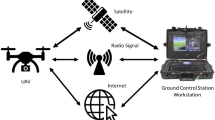Abstract
The application of VANET can be divided into two types: security and non-security. Non-secure applications are primarily used to provide entertainment information. Secure applications will provide information to the driver in advance. Therefore, the delay and reliability of communication are strictly required for secure applications. In this paper, we propose a kind of demand-aware medium access control protocol based on multichannel cooperation in vehicular ad hoc networks. First, the scheme uses RSU (the roadside unit) to broadcast the secure query packets, and the node sends the emergency information of the vehicle node through the advance reservation control slot. Then, time slot will be divided dynamically according to the demand of the secure data, and each node will be coordinated by RSU to reduce the collision probability and safe data packet delay. The simulation results show that the proposed medium access control scheme can improve the network throughout and reduce the end-to-end transmission delay compared with the traditional 802.11p protocol.







Similar content being viewed by others
References
Uzcategui, R., & Acosta-Marum, G. (2009). Wave: A tutorial. IEEE Communications Magazine, 47(5), 126–133.
Wang, Q., Fan, P., & Letaief, K. (2012). On the joint V2I and V2 V scheduling for cooperative VANETs with network coding. IEEE Transactions on Vehicular Technology, 61(1), 62–73.
Altintas, O., & Ekici, E. (2009). Wireless access in vehicular environments. Eurasip Journal on Wireless Communications & Networking, 2009(1), 1–2.
Wang, Z., & Hassan, M. (2008). How much of DSRC is available for non-safety use? ACM international workshop on vehicular inter-networking, pp. 23–29.
Reinders, R., Van Eenennaam, M., Karagiannis, G., et al. (2011). Contention window analysis for beaconing in VANETs. In: Wireless communications and mobile computing conference (pp. 1481–1487).
Nagaraj, S. R., & Nalini, N. (2016). Performance analysis of proactive congestion control techniques for VANETs. In: International conference on wireless communications, signal processing and networking (pp. 352–356). IEEE.
Kim, B., Kang, I., & Kim, H. (2014). Resolving the unfairness of distributed rate control in the IEEE WAVE safety messaging. IEEE Transactions on Vehicular Technology, 63(5), 2284–2297.
Park, Y., & Kim, H. (2013). Collision control of periodic safety messages with strict messaging frequency requirements. IEEE Transactions on Vehicular Technology, 62(2), 843–852.
Booysen, M. J., Zeadally, S., & Rooyen, G. J. V. (2012). Performance comparison of media access control protocols for vehicular ad hoc networks. IET Networks, 1(1), 10–19.
Dang, D. N. M., Hong, C. S., Lee, S., et al. (2014). An efficient and reliable MAC in VANETs. IEEE Communications Letters, 18(18), 616–619.
Cha, J. R., & Kim, J. H. (2005). Novel anti-collision algorithms for fast object identification in RFID system. In: International conference on parallel and distributed systems—Workshops (pp. 63–67). IEEE Computer Society.
Wang, Q., Leng, S., Fu, H., et al. (2012). An IEEE 802.11p-based multichannel MAC scheme with channel coordination for vehicular ad hoc networks. IEEE Transactions on Intelligent Transportation Systems, 13(2), 449–458.
Bilstrup, K., Uhlemann, E., & Bilstrup, U. (2009). On the ability of the 802.11p MAC method and STDMA to support real-time vehicle-to-vehicle communication. Eurasip Journal on Wireless Communications & Networking, 2009(1), 5.
Shah, A. F. M. S., & Mustari, N. (2016). Modeling and performance analysis of the IEEE 802.11P enhanced distributed channel access function for vehicular network. In: IEEE future technologies conference (pp. 173–178).
Shao, C., Leng, S., Zhang, Y., et al. (2015). Performance analysis of connectivity probability and connectivity-aware MAC protocol design for platoon-based VANETs. IEEE Transactions on Vehicular Technology, 64(12), 5596–5609.
Acknowledgements
This work was supported by National Natural Science Foundation of China (61771252, 61471203), Basic Research Program of Jiangsu Province (BK20171444), “The Six talents High Peaks” Funding Project of Jiangsu Province (DZXX-041), Major Nature Science Foundation of Jiangsu Universities (18KJA51005), Young Talents Support Project of Jiangsu Scientific and Technological Association, The object of Jiangsu Province 5th “333 Project”, The Practice Innovation Program for College Graduates of Jiangsu Province (JSCX17_0224), “1311” Talents Funding Project of Nanjing University of Posts and Telecommunications.
Author information
Authors and Affiliations
Corresponding author
Additional information
Publisher's Note
Springer Nature remains neutral with regard to jurisdictional claims in published maps and institutional affiliations.
Rights and permissions
About this article
Cite this article
Zhao, H., Zhang, M., Gao, K. et al. A Multi-channel Cooperative Demand-Aware Media Access Control Scheme in Vehicular Ad-Hoc Network. Wireless Pers Commun 104, 325–337 (2019). https://doi.org/10.1007/s11277-018-6022-9
Published:
Issue Date:
DOI: https://doi.org/10.1007/s11277-018-6022-9




